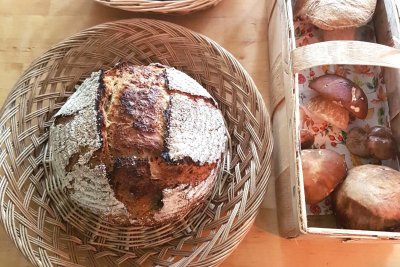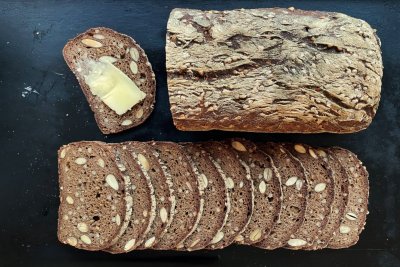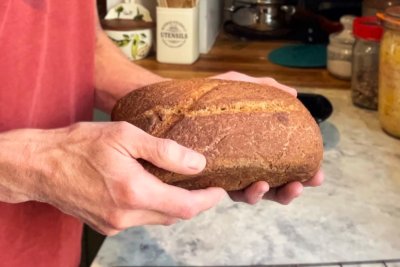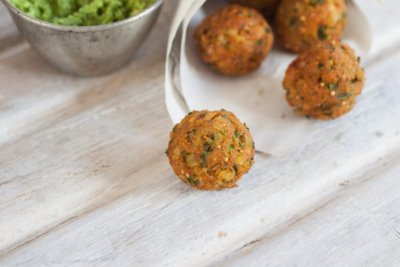Sustain / Real Bread Campaign / Recipes
Vrekkenbrood
A family recipe from a Prussian grandmother.

This recipe was shared by Veronica Kouwenhoven, who says: “My grandmother, Elsa Willner, was born in 1890 in the Prussian town of Sagan in 1890, now Zagan in Poland. She was taught to bake by her mother, who was taught by her mother and so on. My great grandfather was a farmer and also beekeeper, so honey was plentiful."
"Here is my grandmother’s recipe, which I have adapted slightly. She used the old dough method for extra rising power, which will only work if you bake every day like she did, so I sometimes use a little fresh yeast. Sometimes Elsa would add stuff like poppyseeds, or whatever she could lay her hands on. When she moved to the Netherlands, where the dark honey and/or treacle she used in Prussia were difficult to come by, she used stroop (dark, thick syrup) as a substitute. I have reverted to the original ingredients. My grandmother used to knead her dough and then put it in the cellar to prove, but I take a more modern route."
"My grandmother did not give this loaf a name but I jokingly call it vrekkenbrood, which means miser’s bread as it was originally a way to stretch money and resources. It is probably the tastiest loaf ever.”
Ingredients
For the levain
40g liquid (100% hydration) wholemeal rye sourdough starter (preferably stoneground organic)
80g water
80g wholemeal rye flour
For the pap
125g any sourdough bread (stale)
125g boiling water
2tbs poppy (or other small) seeds
50g molasses
50g honey
1tbs sourdough starter
For the final dough
400g white bread flour (preferably stoneground organic)
200g of the levain
All of the pap
175g water (at room temperature)
8g salt
2g fresh yeast (optional - not necessary if your levain is strong)
Method
Two evenings before baking day, make sure your starter is very active and use it at its peak to build the levain and then cover.
Make the pap by chopping the stale sourdough bread into cubes, soaking them in the boiling water and then zap in the food processor until there are no lumps. (The pap was often replaced by leftover oat porridge, which tastes just as good.)
Add the poppyseeds, molasses and honey, leave to cool, add a heaped tablespoon of sourdough starter and then cover.
Leave the levain and pap at room temperature overnight to ferment.
The next morning, mix together all of the final dough ingredients until fully incorporated, cover and leave to rest for an hour.
Do coil folds (see baker’s tips) half an hour apart until the dough comes together. Put the dough into a large container or covered bowl, making a mental note of how high in the bowl the top is, and bulk prove at room temperature (about 18°C to 20°C) until the height has increased by about 50-65%.
Transfer the container/bowl into the fridge (at 3°C) and leave overnight.
The next morning, preshape the dough according to your proving basket and baking pot, leave to rest for half an hour, then shape again, put it into a well-floured banneton (or other type of proving basket) for an hour.
Place a dutch oven (or lidded casserole dish) into the oven and pre-heat to 250°C.
Turn the dough out, seam side down, onto a dusted peel (or flat tray/board) and score the top of the dough.
Gently slide the dough into the dutch oven, put the lid on and close the oven. Turn the oven down to 230°C and bake for 30 minutes. Remove the lid and bake for a further 15 minutes.
Remove the bread from pot and leave on a wire rack to cool.
Baker’s tips
Coil folds are where you lift the dough in the middle and let first one side and then the other coil under itself, before turning by 90 degrees and repeating on the other two sides - there are lots of instructional videos on the Internet.
This soft, slightly sweet bread keeps fresh longer than usual and has a taste to die for. It is a great partner to sharp cheeses.
About the baker
Veronica Kouwenhoven is a keen homebaker in the Netherlands. She learned sourdough baking from her grandmother and has “been baking on and off for more than half a century, the off being when I had no access to an oven.”
Recipe text © Veronica Kouwenhoven. Reproduction prohibited without written permission of the copyright holder.
Published Saturday 25 February 2023
Real Bread Campaign: Finding and sharing ways to make bread better for us, our communities and planet.




